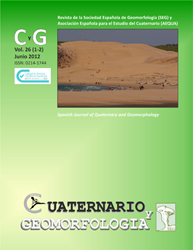Intercalaciones de polvo sahariano en paleodunas bioclásticas de Fuerteventura (Islas Canarias)
Palabras clave:
paleodunas, polvo sahariano, dust, lluvia de sangre, Pleistoceno Superior, Fuerteventura, Islas CanariasResumen
En las Canarias orientales (Lanzarote y Fuerteventura) abundan las formaciones dunares, tanto funcionales como relictas. Estas últimas, debido a su utilización como canteras de áridos, presentan secuencias de gran interés geomorfológico y paleoclimático. En ellas se reconocen estratos de color marrón claro y aspecto terroso que contienen conchas de gasterópodos terrestres y nidos de insectos. La bibliografía los identifica como paleosuelos derivados de la alteración de las arenas o con aportes arcillosos saharianos. Sin embargo, no se observan rasgos que indiquen la existencia en el pasado de procesos edafogenéticos que hayan dado lugar a estas formaciones. El estudio granulométrico, geoquímico y mineralógico de una secuencia localizada en Corralejo (Fuerteventura), en el que se diferencian dos estratos terrosos, apunta a un origen derivado de la mezcla de arenas bioclásticas con polvo sahariano (dust), predominando en éste la fracción limosa y siendo el cuarzo el mineral más destacable. Las dataciones de 14C, realizadas sobre conchas de gasterópodos terrestres, permiten establecer una secuencia temporal finipleistocena para los dos estratos de textura areno-franca, que se habrían formado en situaciones paleoclimáticas caracterizadas por deposiciones masivas de polvo sahariano, en forma de lluvia de sangre, bajo un clima más húmedo que el actual.Descargas
Los datos de descargas todavía no están disponibles.


